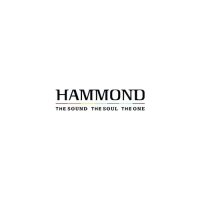phase inverter driving push-pull output
tubes V9
and VI 0. A feedback circuit from
the
output transformer
secondary
(R336
and
R337)
makes the
pedal
response
more
uniform
by
reducing
speaker resonance.
I
R336
is adjusted
at
the factory.
2-^6.
POWER
SUPPLY (See
Figure
5-4).
-
The
power
supply uses a 5U4 rectifier
tube
with conventional filtering
circuit.
2-7.
L-10QA PERCUSSION
VOICING CIRCUITRY
(See
Figure
5-5).
2-8.
MODE
SWITCH
-
With the ''Mode
Switch"
in any
of the reiteration
positions, the
harmonics
necessary to produce
the
"Chime",
"Guitar", and "Banjo" are all
fed into the "A"
reiteration channel only,
while the "Marimba"
and
"Xylophone"
effects
feed
harmonics
into both the
"A"
and
the
"B"
channels.
This
spht
into the
"A" and "B"
channels
only occurs
with the
use of reiteration.
Without
reiteration,
all
effects are routed into the regular
percussion
system. The two reiteration
channels are
identical.
You
will
note
that across the
secondary
windings
of the
two input
trans-
formers
is located
a
field-effect
transistor.
These gates
Q300
and
Q303,
are fed alter-
nating pulses from
a
bistable
multivibrator
which
supplies alternate
pulses
to
each
one
of
these
gates. That
is; one
is On, while the
other
is
off.
These gates
shunt the
signal
to ground, thereby
making
the channel
inoperative.
These
individual signals
are
further amplified
by
a
one
stage transistor
amplifier,
Q301
for
the
"A"
channel, and
Q302
for the
"B" channel.
They
are
then
mixed
together
and fed
to a common
amphfier,
Q307,
which
in turn feeds
this
percussion signal
to
the input
side
of
the
swell
pedal.
The
multivibrator
which
supphes the keying
pulse
for
these two
gates does not run
continually,
but
rather
is
turned
off
and on
each time
a
key
is
depressed
on the upper
manual. The
multi-
vibrator
consists
of
Q305
and
Q306.
The
multivibrator
rate varies
with
the
applied
base
voltage.
This
voltage
is applied through
the "Mode
Switch"
and R684
and R685.
Q304
provides
the
necessary
switch
pulse
to start the
multivibrator.
NOTE
Whenever
the
reiteration
is used,
it completely
bypasses the percus-
sion
section of
the AO—
42
amplifier.
With
the "Mode Switch" in
the
"Normal",
"Vibrato",
or
"Delayed Vibrato"
position,
the various pre-voiced
percussions
are
routed
to
a
percussion preamphfier
made
up
of
Q314
and
Q313.
These amplified
signals
are
then
routed
into
the regular
Hammond
percussion
system at
the
col-
lector of
Q201.
With
the "Mode Switch"
in the "Normal"
position all percussion
voices
sound
as normal; that is, they have
no
vibrato.
NOTE
To obtain the following vibrato
effects
it
will
be necessary
to
de-
press
one or
both of
the
VIBRATO
tabs.
With the "Mode
Switch" in the
"Vibrato"
position,
a
portion of
the
percussion
signal
is
taken from
the input
side of
the
Expres-
sion pedal and
routed
through R670,
the
"Mode
Switch", and
is then
fed
to
the grid
of
VI A
(Pin
2).
Here
the percussion
voices
are
amplified
and
fed
to
the
vibrato
phase
shift ampUfier.
All
voices
so
routed
now
appear with
vibrato.
With the
"Mode Switch"
in the "Delayed
Vibrato"
position,
a portion
of
the percus-
sion
signal
is
taken from
the
input
side of
the Expression
pedal, and routed
to a
voltage
divider
made
up
of R682
and
R681.
This weak signal
is
fed
to
the
base
of
Q3
1 2.
It
will
be noted that
the
emitter of
this
stage is not bypassed and that
the output
of
this
stage is
relatively
low. During keying,
after
a predetermined
time
lag
(.5
seconds),
the
charge
on C631
is depleted
by
Q308
and
Q309.
With this
charge depleted,
Q308
and
Q309
stop conducting
and
their
respective collectors
assume the
supply
potential
+
1 2
V. This
+
1
2V.
from
the
collector of
Q309
is
now apphed
to
the
base
Q3
1
0,
thereby
placing
Q3
1 0 and
Q3
1
1
in
a
state
of
conduction.
With
Q3
1 1 now
conducting, C633
is
placed across
the
emitter resistor
of
Q3
1 2.
This
materially
increases
the
gain
of this
stage,
and as
the
percussion
is
dying
away,
feeds
this ampli-
fied
portion of
the
fading
percussion signal
through
the
"Mode
Switch",
and
R683
to
the
grid
of
VI A
(Pin
2).
There the
signal
is ampUfied
and
fed
to the
Vibrato Phase-
Shift amphfier.
All voices
so
routed
now
appear
with
a
vibrato
tail-off.

